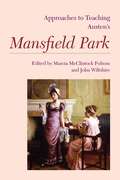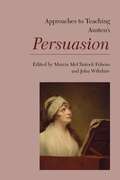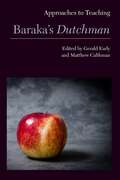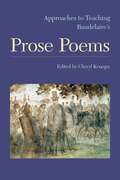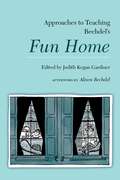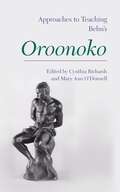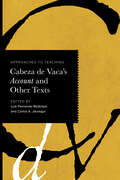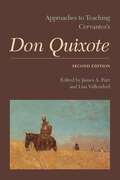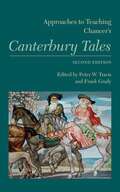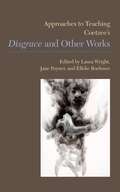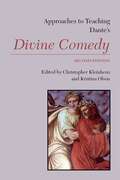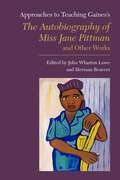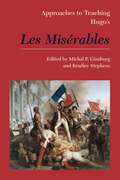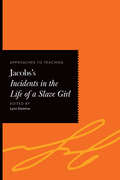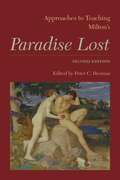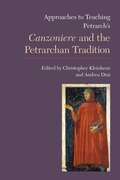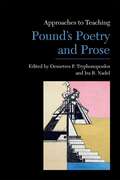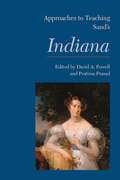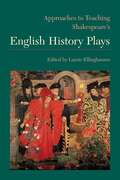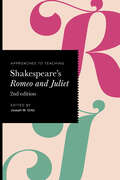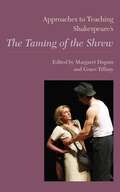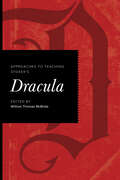- Table View
- List View
Approaches to Teaching Austen's Mansfield Park (Approaches to Teaching World Literature #135)
by Marcia McClintock Folsom John WiltshireThere were no reviews of Mansfield Park when it first appeared in 1814. Austen's reputation grew in the Victorian period, but it was only in the twentieth century that formal and sustained criticism began of this work, which addresses the controversies of its time more than Austen's earlier novels did. Lionel Trilling praised Mansfield Park for exploring the difficult moral life of modernity; Edward Said brought postcolonial theory to the study of the novel; and twenty-first-century critics scrutinize these and other approaches to build on and go beyond them.This volume is the third in the MLA Approaches series to deal with Austen's work (Pride and Prejudice and Emma were the subject of the first and second volumes on Austen, respectively). It provides information about editions, film adaptations, and digital resources, and then nineteen essays discuss various aspects of Mansfield Park, including the slave trade, the theme of reading, elements of tragedy, gift theory, landscape design, moral improvement in the spirit of Samuel Johnson and of the Reformation, sibling relations, card playing, and interpretations of Fanny Price, the heroine, not as passive but as having some control.
Approaches to Teaching Austen's Persuasion (Approaches to Teaching World Literature #166)
by Marcia M. Folsom John WiltshireJane Austen is a favorite with many students, whether they've read her novels or viewed popular film adaptations. But Persuasion, completed at the end of her life, can be challenging for students to approach. They are surprised to meet a heroine so subdued and self-sacrificing, and the novel's setting during the Napoleonic wars may be unfamiliar. This volume provides teachers with avenues to explore the depths and richness of the novel with both Austen fans and newcomers.Part 1, "Materials," suggests editions for classroom use, criticism, and multimedia resources. Part 2, "Approaches," presents strategies for teaching the literary, contextual, and philosophical dimensions of the novel. Essays address topics such as free indirect discourse and other narrative techniques; social class in Austen's England; the role of the navy during war and peacetime; key locations in the novel, including Lyme Regis and Bath; and health, illness, and the ethics of care.
Approaches to Teaching Baraka's Dutchman (Approaches to Teaching World Literature #153)
by Matthew CalihmanFirst performed in 1964, Amiri Baraka's play about a charged encounter between a black man and a white woman still has the power to shock. The play, steeped in the racial issues of its time, continues to speak to racial violence and inequality today.This volume offers strategies for guiding students through this short but challenging text. Part 1, "Materials," provides resources for biographical information, critical and literary backgrounds, and the play's early production history. The essays of part 2, "Approaches," address viewing and staging Dutchman theatrically in class. They help instructors ground the play artistically in the black arts movement, the beat generation, the theater of the absurd, pop music, and the blues. Background on civil rights, black power movements, the history of slavery, and Jim Crow laws helps contextualize the play politically and historically.
Approaches to Teaching Baudelaire's Prose Poems (Approaches to Teaching World Literature #142)
by Cheryl KruegerA prolific poet, art critic, essayist, and translator, Charles Baudelaire is best known for his volumes of verse (Les Fleurs du Mal [Flowers of Evil]) and prose poems (Le Spleen de Paris [Paris Spleen]). This volume explores his prose poems, which depict Paris during the Second Empire and offer compelling and fraught representations of urban expansion, social change, and modernity. Part 1, "Materials," surveys the valuable resources available for teaching Baudelaire, including editions and translations of his oeuvre, historical accounts of his life and writing, scholarly works, and online databases. In Part 2, "Approaches," experienced instructors present strategies for teaching critical debates on Baudelaire's prose poems, addressing topics such as translation theory, literary genre, alterity, poetics, narrative theory, and ethics as well as the shifting social, economic, and political terrain of the nineteenth century in France and beyond. The essays offer interdisciplinary connections and outline traditional and fresh approaches for teaching Baudelaire's prose poems in a wide range of classroom contexts.
Approaches to Teaching Bechdel's Fun Home (Approaches to Teaching World Literature #154)
by Judith Kegan GardinerAlison Bechdel's Fun Home: A Family Tragicomic has quickly joined the ranks of celebrated literary graphic novels. Set in part at a family-run funeral home, the book explores Alison's complicated relationship with her father, a closeted gay man. Amid the tensions of her home life, Alison discovers her own lesbian sexuality and her talent for drawing. The coming-of-age story and graphic format appeal to students. However, the book's nonlinear structure; intertextuality with modernist novels, Greek myths, and other works; and frank representations of sexuality and death present challenges in the classroom.This volume offers strategies for teaching Fun Home in a variety of courses, including literature, women's and gender studies, art, and education. Part 1, "Materials," outlines the text's literary, historical, and theoretical allusions. The essays of part 2, "Approaches," emphasize the work's genres, including autobiography and graphic narrative, as well as its psychological dimensions, including trauma, disability, and queer identity. The essays give options for reading Fun Home along with Bechdel's letters and drafts; her long-running comic strip, Dykes to Watch Out For; the Broadway musical adaptation of the book; and other stories of LGBTQ lives.
Approaches to Teaching Behn's Oroonoko (Approaches to Teaching World Literature #127)
by Cynthia Richards and Mary Ann O’DonnellOnce merely a footnote in Restoration and eighteenth-century studies and rarely taught, Oroonoko; or, The Royal Slave (1688), by Aphra Behn, is now essential reading for scholars and a classroom favorite. It appears in general surveys and in courses on early modern British writers, postcolonial literature, American literature, women's literature, drama, the slave narrative, and autobiography.Part 1 of this volume, "Materials," provides not only resources for the teacher of Oroonoko but also a brief chronology of Behn's life and work. In part 2, "Approaches," essays offer a diversity of perspectives appropriate to a text that challenges student assumptions and contains not one story but many: Oroonoko as a romance, as a travel account, as a heroic tragedy, as a window to seventeenth-century representations of race, as a reflection of Tory-Whig conflict in the time of Charles II.
Approaches to Teaching Cabeza de Vaca's Account and Other Texts (Approaches to Teaching World Literature #181)
by Luis Fernando Restrepo Carlos A. JáureguiIn 1527 Ã�lvar Núñez Cabeza de Vaca journeyed from Spain to Florida with the ill-fated Pánfilo de Narváez expeditionâ€"and ended up wandering by land for years with a small band of survivors before reaching Spanish outposts in modern-day Mexico. He later traveled to South America as an appointed provincial governor, only to be sent back to Spain in chains some years after his arrival. His written works describing his experiences provide insights into the lives of the indigenous peoples of the Americas and the attitudes of the Spanish conquistadores.This volume provides background about the texts and discusses new ways to teach them, challenging outdated readings that erase the violence of Spanish imperialism. Essays examine the role of the enslaved African Esteban in Cabeza de Vaca's account of the North American expedition, the indigenous and Spanish women who appear in the explorer's texts, Cabeza de Vaca's performance of multiple gender roles, and the reception of these works as examples of Chicano or Latin American literature. The volume also explores connections to archaeological findings and food studies.
Approaches to Teaching Cervantes's Don Quixote (Approaches to Teaching World Literature #134)
by James A. Parr and Lisa VollendorfThis second edition of Approaches to Teaching Cervantes'sDon Quixote highlights dramatic changes in pedagogy and scholarship in the last thirty years: today, critics and teachers acknowledge that subject position, cultural identity, and political motivations afford multiple perspectives on the novel, and they examine both literary and sociohistorical contextualization with fresh eyes.Part 1, "Materials," contains information about editions of Don Quixote, a history and review of the English translations, and a survey of critical studies and Internet resources. In part 2, "Approaches," essays cover such topics as the Moors of Spain in Cervantes's time; using film and fine art to teach his novel; and how to incorporate psychoanalytic theory, satire, science and technology, gender, role-playing, and other topics and techniques in a range of twenty-first-century classroom settings.
Approaches to Teaching Chaucer's Canterbury Tales (Approaches to Teaching World Literature #131)
by Peter W. Travis Frank GradyChaucer's Canterbury Tales was the subject of the first volume in the Approaches to Teaching series, published in 1980. But in the past thirty years, Chaucer scholarship has evolved dramatically, teaching styles have changed, and new technologies have created extraordinary opportunities for studying Chaucer. This second edition of Approaches to Teaching Chaucer's Canterbury Tales reflects the wide variety of contexts in which students encounter the poem and the diversity of perspectives and methods instructors bring to it. Perennial topics such as class, medieval marriage, genre, and tale order rub shoulders with considerations of violence, postcoloniality, masculinities, race, and food in the tales.The first section, "Materials," reviews available editions, scholarship, and audiovisual and electronic resources for studying The Canterbury Tales. In the second section, "Approaches," thirty-six essays discuss strategies for teaching Chaucer's language, for introducing theory in the classroom, for focusing on individual tales, and for using digital resources in the classroom. The multiplicity of approaches reflects the richness of Chaucer's work and the continuing excitement of each new generation's encounter with it.
Approaches to Teaching Coetzee's Disgrace and Other Works (Approaches to Teaching World Literature #130)
by Laura Wright, Jane Poyner, and Elleke BoehmerThe novels of the South African writer J. M. Coetzee won him global recognition and the Nobel Prize in Literature in 2003. His work offers substantial pedagogical richness and challenges. Coetzee treats such themes as race, aging, gender, animal rights, power, violence, colonial history and accountability, the silent or silenced other, sympathy, and forgiveness in an allusive and detached prose that avoids obvious answers or easy ethical reassurance.Part 1 of this volume, "Materials," identifies secondary materials, including multimedia and Internet resources, that will help instructors guide their students through the contextual and formal complexities of Coetzee's fiction. In part 2, "Approaches," essays discuss how to teach works that are sometimes suspicious of teachers and teaching. The essays aim to help instructors negotiate Coetzee's ironies and allegories in his treatment of human relationships in a changing South Africa and of the shifting connections between human beings and the biosphere.
Approaches to Teaching Dante's Divine Comedy (Approaches to Teaching World Literature #163)
by Christopher Kleinhenz and Kristina OlsonDante's Divine Comedy can compel and shock readers: it combines intense emotion and psychological insight with medieval theology and philosophy. This volume will help instructors lead their students through the many dimensions--historical, literary, religious, and ethical--that make the work so rewarding and enduringly relevant yet so difficult.Part 1, "Materials," gives instructors an overview of the important scholarship on the Divine Comedy. The essays of part 2, "Approaches," describe ways to teach the work in the light of its contemporary culture and ours. Various teaching situations (a first-year seminar, a creative writing class, high school, a prison) are considered, and the many available translations are discussed.
Approaches to Teaching Dostoevsky's Crime and Punishment (Approaches to Teaching World Literature #171)
by Michael R. Katz and Alexander BurryRecounting the murder of an elderly woman by a student expelled from university, Crime and Punishment is a psychological and political novel that portrays the strains on Russian society in the middle of the nineteenth century. Its protagonist, Raskolnikov, moves in a world of dire poverty, disillusionment, radicalism, and nihilism interwoven with religious faith and utopianism. In Dostoevsky's innovative style, which he called fantastic realism, the narrator frequently reports from within the protagonist's mind. The depiction of the desperate lives of tradespeople, students, alcoholics, prostitutes, and criminals gives readers insight into the urban society of St. Petersburg at the time.The first part of this book offers instructors guidance on editions and translations, a map of St. Petersburg showing locations mentioned in the novel, a list of characters and an explanation of the Russian naming system, and recommendations for further reading. In the second part, essays analyze key scenes, address many of Dostoevsky's themes, and consider the roles of ethics, gender, money, Orthodox Christianity, and social justice in the narrative. The volume concludes with essays on digital media, film adaptations, and questions of translation.
Approaches to Teaching Gaines's The Autobiography of Miss Jane Pittman and Other Works (Approaches to Teaching World Literature #161)
by John Wharton Lowe and Herman BeaversThe Autobiography of Miss Jane Pittman tells the story of a woman, a community, and the African American experience from the Civil War through Jim Crow to the civil rights movement. This narrative and Gaines's other novels and short stories explore the life of blacks in the South, their religious traditions and folkways, and their struggles under oppression. The southern communities described are diverse: blacks, creoles of color, poor whites, and wealthy landowners.Part 1 of this volume provides biographical information about Ernest Gaines and a discussion of critical and background studies of his narrative. The essays in part 2 will help teachers of African American literature, American literature, and southern literature convey to their students various aspects of Gaines's work and the adaptations of it in relation to southern literature, history, music, folk culture, and vernaculars of English.
Approaches to Teaching Hugo's Les Misérables (Approaches to Teaching World Literature #150)
by Michal P. Ginsbug Bradley StephensThe greatest work of one of France's greatest writers, Victor Hugo's Les Misérables has captivated readers for a century and a half with its memorable characters, its indictment of injustice, its concern for those suffering in misery, and its unapologetic embrace of revolutionary ideals. The novel's length, multiple narratives, and encyclopedic digressiveness make it a pleasure to read but a challenge to teach, and this volume is designed to address the needs of instructors in a variety of courses that include the novel in excerpts or as a whole.Part 1 of the volume, "Materials," provides guidance on editions in French and in English translation, biographies, criticism, and maps. Part 2, "Approaches," contains essays that discuss the novel's conceptions of misère, sexuality, and the politics of the time and that demonstrate techniques for teaching context including the book's literary market, its adaptations, its place in popular culture, and its relation to other novels of its time.
Approaches to Teaching Jacobs's Incidents in the Life of a Slave Girl (Approaches to Teaching World Literature #176)
by Lynn DominaOne of the most commonly taught slave narratives, Harriet Jacobs's Incidents in the Life of a Slave Girl is rightly celebrated for its progressive and distinctive appeals to dismantle the dehumanizing system of American slavery. Depicting the abuse Jacobs experienced, her years in hiding, and her escape to the North, the work evokes sympathy for Jacobs as a woman and a mother. Today, it continues to inform readers about gender and sexuality, power and justice, and Black identity in the United States.Part 1 of this volume, "Materials," discusses different editions of the work and suggests background readings. The essays in part 2, "Approaches," explore Jacobs's literary techniques and influences, drawing on autobiography theory, medical humanities, and theology, among other perspectives. Contributors also propose pairings with historical and recent literary works as well as teaching approaches involving visual arts, geography, archives, digital humanities, and service learning.
Approaches to Teaching Langland's Piers Plowman (Approaches to Teaching World Literature #151)
by Thomas A. GoodmannA series of dream visions, Piers Plowman is a moral reckoning of the whole of medieval England, in which every part of society--from church and king to every sort of "folk"--is considered in the light of the narrator's interpretation of Christian revelation. The Middle English poem, rich and beautiful, is a particular challenge to teach: it exists in three versions, lacks a continuous narrative, is written in a West Midlands dialect, weaves a complex allegory, and treats complicated social and political issues, such as labor, Lollardy, and popular uprising.Part 1 of this volume, "Materials," discusses the different versions, critical and classroom editions, and translations of the poem, as well as the many secondary sources. Part 2, "Approaches," helps students engage with the poem's versification, understand its protagonist and its treatment of poverty and equity, and discern connections to the work of other medieval poets, such as Dante and Chaucer.
Approaches to Teaching Milton's Paradise Lost: second edition (Approaches to Teaching World Literature #122)
by Regina Schwartz Achsah Guibbory Jessica Wolfe Abraham Stoll Gregory M. Semenza Elizabeth Sauer Anthony Welch Peter C. Herman Randall IngramThis second edition of Approaches to Teaching Milton's Paradise Lost addresses Milton in the light of the digital age, new critical approaches to his poem, and his continued presence in contemporary culture. It aims to help instructors enliven the teaching of Paradise Lost and address the challenges presented to students by the poem--the early modern syntax and vocabulary, the political and theological contexts, and the abounding classical references.The first part of the volume, "Materials," evaluates the many available editions of the poem, points to relevant reference works, recommends additional reading, and outlines useful audiovisual and online aids for teaching Milton's epic poem. The essays in the second part, "Approaches," are grouped by several themes: literary and historical contexts, characters, poetics, critical approaches, classrooms, and performance. The essays cover epic conventions and literary and biblical allusions, new approaches such as ecocriticism and masculinity studies, and reading Milton on the Web, among other topics.
Approaches to Teaching Petrarch's Canzoniere and the Petrarchan Tradition (Approaches to Teaching World Literature #129)
by Christopher Kleinhenz Andrea DiniOne of the most important authors of the Middle Ages, Petrarch occupies a complex position: historically, he is a medieval author, but, philosophically, he heralds humanism and the Renaissance. Teachers of Petrarch's Canzoniere and his formative influence on the canon of Western European poetry face particular challenges. Petrarch's poetic style brings together the classical tradition, Christianity, an exalted sense of poetic vocation, and an obsessive love for Laura during her life and after her death in ways that can seem at once very strange and--because of his style's immense influence--very familiar to students. This volume aims to meet the varied needs of instructors, whether they teach Petrarch in Italian or in translation, in surveys or in specialized courses, by providing a wealth of pedagogical approaches to Petrarch and his legacy.Part 1, "Materials," reviews the extensive bibliography on Petrarch and Petrarchism, covering editions and translations of the Canzoniere, secondary works, and music and other audiovisual and electronic resources. Part 2, "Approaches," opens with essays on teaching the Canzoniere and continues with essays on teaching the Petrarchan tradition. Some contributors use the design and structure of the Canzoniere as entryways into the work; others approach it through discussion of Petrarch's literary influences and subject matter or through the context of medieval Christianity and culture. The essays on Petrarchism map the poet's influence on the Italian lyric tradition as well as on other national literatures, including Spanish, French, English, and Russian.
Approaches to Teaching The Plum in the Golden Vase (Approaches to Teaching World Literature #159)
by Andrew SchonebaumThe Plum in the Golden Vase (also known as The Golden Lotus) was published in the early seventeenth century and may be the first long work of Chinese fiction written by a single (though anonymous) author. Featuring both complex structural elements and psychological and emotional realism, the novel centers on the rich merchant Ximen Qing and his household and describes the physical surroundings and material objects of a Ming Dynasty city. In part a social, political, and moral critique, the novel reflects on hierarchical power relations of family and state and the materialism of life at the time.The essays in this volume provide ideas for teaching the novel using a variety of approaches, from questions of genre, intertextuality, and the novel's reception to material culture, family and social dynamics, and power structures in sexual relations. Insights into the novel's representation of Buddhism, Chinese folk religion, legal culture, class, slavery, and obscenity are offered throughout the volume.
Approaches to Teaching Pound's Poetry and Prose (Approaches to Teaching World Literature #165)
by Demetres P. Tryphonopoulos and Ira B. NadelKnown for his maxim "Make it new," Ezra Pound played a principal role in shaping the modernist movement as a poet, translator, and literary critic. His works, with their complex structures and layered allusions, remain widely taught. Yet his known fascism, anti-Semitism, and misogyny raise issues about dangerous ideologies that influenced his work and that must be addressed in the classroom.The first section, "Materials," catalogs the print and digital editions of Pound's works, evaluates numerous secondary sources, and provides a history of Pound's critical contexts. The essays in the second section, "Approaches," offer strategies for guiding students toward a clearer understanding of Pound's difficult works and the context in which they were written.
Approaches to Teaching Sand's Indiana (Approaches to Teaching World Literature #137)
by The Modern Language Association of AmericaIndiana, George Sand's first solo novel, opens with the eponymous heroine brooding and bored in her husband's French countryside estate, far from her native Île Bourbon (now Réunion). Written in 1832, the novel appeared during a period of French history marked by revolution and regime change, civil unrest and labor concerns, and slave revolts and the abolitionist movement, when women faced rigid social constraints and had limited rights within the institution of marriage. With this politically charged history serving as a backdrop for the novel, Sand brings together Romanticism, realism, and the idealism that would characterize her work, presenting what was deemed by her contemporaries a faithful and candid representation of nineteenth-century France.This volume gathers pedagogical essays that will enhance the teaching of Indiana and contribute to students' understanding and appreciation of the novel. The first part gives an overview of editions and translations of the novel and recommends useful background readings. Contributors to the second part present various approaches to the novel, focusing on four themes: modes of literary narration, gender and feminism, slavery and colonialism, and historical and political upheaval. Each essay offers a fresh perspective on Indiana, suited not only to courses on French Romanticism and realism but also to interdisciplinary discussions of French colonial history or law.
Approaches to Teaching Shakespeare's English History Plays (Approaches to Teaching World Literature #145)
by Laurie EllinghausenShakespeare's history plays make up nearly a third of his corpus and feature iconic characters like Falstaff, the young Prince Hal, and Richard III--as well as unforgettable scenes like the storming of Harfleur. But these plays also present challenges for teachers, who need to help students understand shifting dynastic feuds, manifold concepts of political power, and early modern ideas of the body politic, kingship, and nationhood.Part 1 of this volume, "Materials," introduces instructors to the many editions of the plays, the wealth of contextual and critical writings available, and other resources. Part 2, "Approaches," contains essays on topics as various as masculinity and gender, using the plays in the composition classroom, and teaching the plays through Shakespeare's own sources, film, television, and the Web. The essays help instructors teach works that are poetically and emotionally rich as well as fascinating in how they depict Shakespeare's vision of his nation's past and present.
Approaches to Teaching Shakespeare's Romeo and Juliet (Approaches to Teaching World Literature #174)
by Joseph M. OrtizBy the time they encounter Romeo and Juliet in the classroom, many students have already been exposed to various, and sometimes incongruous, manifestations of Shakespeare's work. This volume makes a virtue of students' familiarity with the preconceptions, anachronisms, and appropriations that shape experiences of the work, finding innovative pedagogical possibilities in the play's adaptations and in new technologies that spark students' creative responses.The essays cover a wide area of concerns, such as marriage, gender, queer perspectives, and girlhood, and contributors embrace different ways of understanding the play, such as through dance, editing, and acting. The final essays focus on decolonizing the text by foregrounding both the role of race and economic inequality in the play and the remarkable confluence of Romeo and Juliet and Hispanic culture.
Approaches to Teaching Shakespeare's The Taming of the Shrew (Approaches to Teaching World Literature #123)
by Margaret Dupuis and Grace TiffanyThe impetus for this Approaches to Teaching volume on The Taming of the Shrew grew from the editors' desire to discover why a play notorious for its controversial exploration of conflicts between men and women and the challenges of marriage is enduringly popular in the classroom, in the performing arts, and in scholarship. The result is a volume that offers practical advice to teachers on editions and teaching resources in part 1, "Materials," while illuminating how the play's subtle and complex arguments regarding not just marriage but a host of other subjects--modes of early modern education, the uses of clever rhetoric, intergenerational and class politics, the power of theater--are being brought to life in college classrooms. The essays in part 2, "Approaches," are written by English and theater instructors who have taught in a variety of academic settings and cover topics including early modern homilies and music, Hollywood versions of The Taming of the Shrew, and student performances.
Approaches to Teaching Stoker's Dracula
by William Thomas McBrideThis volume helps teachers contextualize Bram Stoker's Dracula in its historical and cultural moment, considering psychology, technology, gender roles, colonialism, and anxieties about the other. It also situates the novel among the kindred texts that have proliferated since its publication, from film and television to the growing genre of vampire novels.Essays explore the novel in terms of medical humanities, contagion, and the gothic as well as ethnicity, identity, and race. Contributors analyze Dracula in the context of various ancient and modern cultural productions, including classical Indian aesthetics and African American vampire literature, and describe a broad range of classroom settings, including a technical university, a Hispanic-serving institution, and others.
